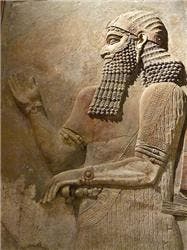Archaeologists used innovative techniques to gain new insights about the third-millennium urban crisis in Mesopotamia some 4,000 years ago. This marked the fall of the Akkadian Empire – the very first empire in the world. The researchers also drew a comparison to modern-day Syria where current events in the wake of climate change and a violent revolution seem to mirror those in ancient times.

It’s believed that at around 2,300 BC the Akkadian empire was hit by a severe drought that lasted for a very long time. This climatic event marked the demise of what’s considered “the cradle of civilization”. First, however, the region which was home to the very first cities in the world was hit by an urban crisis, named so because of a slew of unfortunate events, from migration to violent conflicts, that shattered the cities of Mesopotamia.
Very little is known about this period since the best sources archaeologists had at their disposal were limited to ceramic artifacts and changes in the size of archaeological sites. Ellery Frahm of the University of Sheffield in the UK and colleagues used sophisticated tools like geochemical techniques and rock magnetic analysis to examine trade and the social networks associated with it instead.
The archaeologists looked at 97 obsidian tools excavated earlier from a site called Tell Mozan, known as Urkesh in antiquity, dating from the early Akkadian empire to several centuries after its demise. What they found was that artifacts dating before 2300BC originally came from six sites in Eastern Anatolian, while those post-2300BC or the beginning of the Akkadian demise originated only from two sources, and those were local.
What this tells us is that Urkesh was once a formidable cultural and cosmopolitan city where people from all corners of the empire and beyond came together to trade, reaching civilizations in the Aegean and middle Euphrates.
“Urkesh might have specialised its economy in response to demand for certain commodities, such as metals from the nearby mountains,” says Frahm. “With climate shifts and the end of the empire, the inhabitants might have had to refocus their economy on local production and consumption, covering their own needs rather than engaging in specialised long-distance trade.”
The great drought that crumbled the Akkadian civilization was caused by climate change, some believed in the wake of a volcano’s eruption. Soon after the empire was divided and marked by war.
Remarkably, the urban crisis of Mesopotamia is rather similar to that experienced by Syria, currently engaged in civil war.
“Some archaeologists contend that the Akkadian Empire was brought down by militarism and that violence ended its central economic role in the region, and a governmental collapse is a real possibility in Syria after nearly two years of fighting,” Frahm adds.
The parallelism is emphasized even further by the fact that many farmers in Syria have reported in recent years severe droughts, linked to modern-day climate change.
“Those of us who study people and the past are in a unique position to consider what could happen after the immediate crisis ends,” says Frahm. “What happens to cities when a state falls? How do the residents sustain themselves if that infrastructure collapses? This is the type of contribution that archaeology can make towards improving the future.”
The findings were reported in the Journal of Archaeological Science






